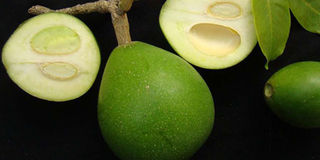White sapote: The delicious, nutritious fruit crop worthy of your consideration

The white sapote fruit. The fruit does well in a variety of soil types as long as there is good drainage. FILE PHOTO | NATION MEDIA GROUP
What you need to know:
- The white sapote is planted widely in the south and central America and has caught up as a favourite fruit in the Mediterranean region and India.
- Mature trees can withstand temperature drops to -6º C without injury, meaning highland frosts in Kenya will not be a problem for white sapote.
- Overripe white sapotes have a flavour similar to overripe bananas.
- White sapote is difficult to root plant, hence no success with cuttings is reported.
DURING MY RESEARCH travels in Nyanza and Western regions, I passed through Kiboswa market and noticed a thriving fruit trade with unique produce.
The two abundant fruits were white sapote and syzygium (zambarau). These struck me because you never find them in such abundance in markets.
In fact all through my childhood zambarau was a wild fruit we ate on the banks of rivers and was not available in markets.
I will talk about zambarau some other time. Today let’s consider white sapote, a nutritious and delicious fruit that is rarely makes it to our plates.
Origin and adaptability: The white sapote (also called the Mexican apple, Casimoroa edulis) is a fruiting tree that occurs wildly and is also cultivated.
The tree is planted widely in the south and central America and has caught up as a favourite fruit in the Mediterranean region and India.
It is also grown commercially in New Zealand and South Africa. Horticulturists in Israel have taken serious interest in the fruit and are credited with breeding a number of varieties with various colours.
White sapote is a subtropical tree suited to growing naturally at elevations of 600-900m above sea level and is occasionally found at elevations as high as 2,700m in areas with moderate rainfalls.
Mature trees can withstand temperature drops to -6º C without injury, meaning highland frosts in Kenya will not be a problem for white sapote.
White sapote does well in a variety of soil types as long as there is good drainage; the trees do very well on sandy loam or even on clay soils with a pH range of 5.6-7.8.
The tree has great adaptability to arid regions, hence a sustainable fruit tree option in areas where other fruit tree species may not thrive.
The white sapote fruit is unusual; It’s size, colour, and shape closely resemble a large green apple. The flesh of a ripe white sapote is custard like and the taste can be described as similar to vanilla pudding, or pumpkin pie.
Overripe white sapotes have a flavour similar to overripe bananas. The skin is bitter and unpalatable to the palate. The seeds are large and usually three to four in number. Seeds are also said to be as toxic as peach seeds if eaten but stories of their sedative effects abound in Mexican folklore.
Propagation and culture: White sapotes are commonly grown from seeds and seedling trees come into bearing seven to eight years after planting. Grafting can also be done but is not common in Kenya due to a lack of known and proven rootstocks.
At Egerton University and amongst some growers in the country, success with air layering has been obtained. The advantage with air layering is that you can produce an advanced tree in a short time.
White sapote is difficult to root plant, hence no success with cuttings is reported.
After planting, young trees should be cut back to about 90cm to encourage a dense low-branching habit. As branches elongate, some heading back should be done to induce lateral growth and proper tree shape formation.
In Kenya, farmers do not apply fertilisers, as they do with other trees. However, for proper growth and productivity a good fertiliser regime is necessary.
Choice of fertiliser types should be based on nature of the soil; but general recommendation is follow the fertiliser regime for citrus fruit trees.
They require great care because they can span more than 100 years in age.
Prof Mulwa is from the Department of Crops, Horticulture and Soils, Egerton University




